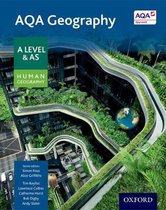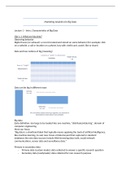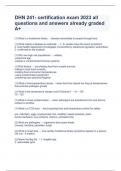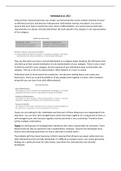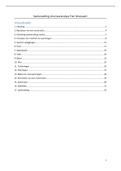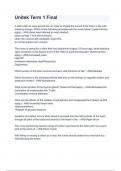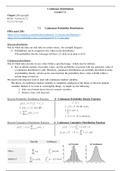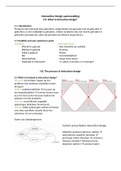Specification
3.2.1.1 Globalisation
o Dimensions of globalisation: flows of capital, labour, products, services and information;
global marketing; patterns of production, distribution and consumption.
o Factors in globalisation: the development of technologies, systems and relationships,
including financial, transport, security, communications, management and information
systems and trade agreements.
3.2.1.2 Global systems
o Form and nature of economic, political, social and environmental interdependence in
the contemporary world.
o Issues associated with interdependence including how: • unequal flows of people,
money, ideas and technology within global systems can sometimes act to promote
stability, growth and development but can also cause inequalities, conflicts and
injustices for people and places • unequal power relations enable some states to drive
global systems to their own advantage and to directly influence geopolitical events,
while others are only able to respond or resist in a more constrained way.
3.2.1.3 International trade and access to markets
o Global features and trends in the volume and pattern of international trade and
investment associated with globalisation.
o Trading relationships and patterns between large, highly developed economies such as
the United States, the European Union, emerging major economies such as China and
India and smaller, less developed economies such as those in sub-Saharan Africa,
southern Asia and Latin America.
o Differential access to markets associated with levels of economic development and
trading agreements and its impacts on economic and societal well-being.
o The nature and role of transnational corporations (TNCs), including their spatial
organisation, production, linkages, trading and marketing patterns, with a detailed
reference to a specified TNC and its impacts on those countries in which it operates.
o World trade in at least one food commodity or one manufacturing product.
o Analysis and assessment of the geographical consequences of global systems to
specifically consider how international trade and variable access to markets underly
and impacts on students' and other people's lives across the globe.
3.2.1.4 Global governance
o The emergence and developing role of norms, laws and institutions in regulating and
reproducing global systems.
o Issues associated with attempts at global governance, including how: • agencies,
including the UN in the post-1945 era, can work to promote growth and stability but
may also exacerbate inequalities and injustices • interactions between the local,
regional, national, international and global scales are fundamental to understanding
global governance.
3.2.1.5 The 'global commons'
o The concept of the ‘global commons’.
o The rights of all to the benefits of the global commons.
o Acknowledgement that the rights of all people to sustainable development must also
acknowledge the need to protect the global commons.
3.2.1.5.1 Antarctica as a global common
o An outline of the contemporary geography, including climate, of Antarctica (including
the Southern Ocean as far north as the Antarctic Convergence) to demonstrate its role
as a global common and illustrate its vulnerability to global economic pressures and
environmental change.
, o Threats to Antarctica arising from: • climate change • fishing and whaling • the search
for mineral resources • tourism and scientific research.
o Critical appraisal of the developing governance of Antarctica. International government
organisations to include United Nations (UN) agencies such as United Nations
Environment Programme (UNEP) and the International Whaling Commission.
o The Antarctic Treaty (1959), the Protocol on Environmental Protection to the Antarctic
Treaty (1991); IWC Whaling Moratorium (1982) – their purpose, scope and systems for
inspection and enforcement.
o The role of NGOs in monitoring threats and enhancing protection of Antarctica.
o Analysis and assessment of the geographical consequences of global governance for
citizens and places in Antarctica and elsewhere to specifically consider how global
governance underlies and impacts on students’ and other people's lives across the
globe.
3.2.1.6 Globalisation critique
o The impacts of globalisation to consider the benefits of growth, development,
integration, stability against the costs in terms of inequalities, injustice, conflict and
environmental impact.
3.2.1.7 Quantitative and qualitative skills
o Students must engage with quantitative and qualitative approaches across the theme
as a whole.
Globalisation
Globalisation is a term used frequently within trade and economics and describes a process of
opening up world trade and markets to transnational companies (TNCs) and an increasingly
interconnected world.
o It is the process of the world’s economies, political systems and cultures becoming
more strongly connected to each other.
o It is a process driven by technological change and rapid advances in communications. It
leads to greater interdependence between countries as goods, services, capital, labour,
knowledge and information move increasingly quickly and freely around the world.
Economic globalisation
o Including industrial and financial globalisation, describes the rise and expansion of
multinational enterprises and the growth of worldwide financial markets and better
access to external financing for corporate, national and sub national borrowers.
o Process caused by: increase in free trade, growth of transnational corporations, faster
cheaper transport, global marketing.
o Characterised by: long distance flows of goods, capital and services as well as
information and market exchanges.
Cultural globalisation
o Involves the movement of ideas, information, images and people around the globe.
o Process caused by: migration, global communication networks, impact of western
culture through media, sport, leisure and celebrity.
o Characterised by spread of ideas, information and images
Political globalisation
o Refers to the spread of political interests to the regions and countries outside the
neighborhood of political actors and long-distance networks of interdependence in
which force, and the threat or promise of force are used.
o Process caused by: growth of Western democracies and their influence on poorer
countries, decline of centralised (communist) economies (though communist political
control is still strong in China and Russia)
o Characterised by: the diffusion of government policy and development of market
economies in former communist states.
, Dimensions of globalisation
Globalisation has many interconnected aspects.
Flows of information and technology
o Information (such as financial data or news of current events) can be spread across the
world very quickly and easily.
o Cheap, reliable and near instantaneous communication between virtually all parts of
the world allows for information to be shared at unprecedented levels.
o The development of rapid spread of e-mail, the internet and social media mean that
large amounts of information can be exchanged instantly across the globe. This allows
people living in different countries to communicate and work together.
o Technology, for example the internet and associated mobile technologies, largely
ignores political boundaries when connecting people and places.
o Increasing flows of information are making the world more interconnected, e.g. people
can learn a lot about different countries and cultures without leaving their own country.
Flows of products
o Global transport systems have never ever been cheaper or more efficient in moving
both people and goods. Transport and time costs have been reduced by the process of
containerization which has enabled more complex and long distance flows of products,
as does air transport which can speed delivery and reduce costs of more valuable or
perishable cargo.
o Transaction costs have been reduced by the improvements in flows of data and the
ease with which capital can be transferred to pay for transactions.
o Historically, manufacturing industries were located in more developed countries. The
products being produced were also sold in the country where they were made.
o In recent decades, manufacturing has decreased in more developed countries, e.g. the
number of people employed in manufacturing in the UK fell from more than 5 million in
1985 to around 2.6 million in 2014.
o Lower labour costs overseas have caused many companies to relocate the production
side of their business abroad – they then import the products to the countries where
they’re sold. E.g. vacuum manufacturer Dyson moved the production side of its
business to Malaysia in 2002, but the vacuums are still sold in the UK.
o As a result of these changes, international trade in manufactured goods is increasing,
e.g. the UK imported £200 billion of manufactured goods in 1990, and £550 billion in
2008.
o Changing flows of products are making the world more interconnected, e.g. many of
the manufactured products bought in the UK have been produced in other countries
and then imported.
Flows of labour
o Flows of labour are movements of people who participate in the workforce from one
country to another.
o More people are moving overseas – international migration increased by over 40%
between 2000 and 2015. Some people move because they have to (e.g. to escape
conflict zone), but many people chose to move for work.
o Some migrants are highly skilled workers (e.g. ITC and medical workers), moving to
more developed countries where wages and working conditions are better. Others are
unskilled workers who move to more developed countries to look for work because of
unemployment or poor wages in their own countries.
o High speed rail networks (such as HS1 in the UK), international airport hubs (Dubai has
now overtaken Heathrow as the world’s busiest airport) have revolutionized travel.
o Increasing flows of people between countries are making the world more
interconnected, e.g. people bring aspects of their culture with them, and countries are
connected because people have family all over the world.

